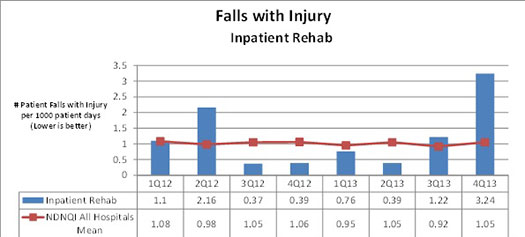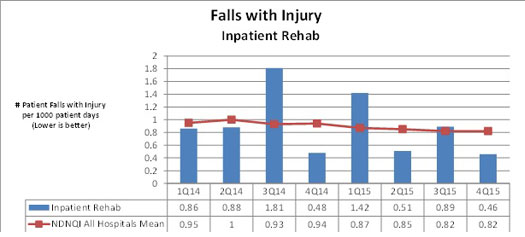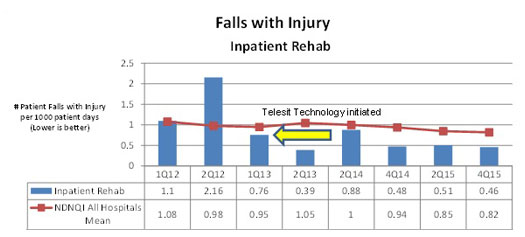Video Monitoring Shows Promise for Rehab Patients
By Jennifer Spalding, RN, CCRN, CBIS
Introduction
Safety is a high priority of the rehabilitation unit at Miami Valley Hospital. Preventing falls and injuries to patients is of utmost importance. The need to accomplish this in a cost-effective way is also very important. The rehabilitation unit was using therapeutic companions to sit with patients who needed close supervision and assistance. This would take members of the staff from the floor to provide one-on-one observation for these patients.
Purpose
The rehabilitation unit needed a way to safely maintain staff on the floor caring for patients and have someone monitor the patients who needed close supervision.
Methods and Materials
In 2012, team leaders, patient care technicians (PCT), and managers from three high-use units in the hospital were trained to use a special video camera and monitoring system, the Tele-Sit. The video camera is on a mobile pole that can be placed in a patient room. The camera shows real-time events; however, they are not recorded. The cameras are centrally monitored by an unlicensed but trained staff member. The person who monitors the patients has contact information – i.e. the name of patient on the monitor screen along with the name of the nurse and PCT caring for the patient. The person monitoring the patient would notify the nurse or the PCT if the patient attempts to get out of bed. Also, the person monitoring the patient would attempt to engage the patient prior to the phone call to the nurse or PCT (Miller,M. et al.). For example, patient A is lying in bed. The patient swings his or her legs out of the bed and sit up. The monitor calls into the room asking the patient if he/she needs assistance. If patient A states that assistance is needed, the monitor informs the patient that he/she is calling for help.
The criteria for Tele-Sit use is risk for falls/impulsiveness, restlessness, and poor cognition. Patients using the system could have a history of falls or a fall risk assessment score greater than or equal to 16. Patients with diagnosis of brain injury and stroke are at a greater risk for falls (Fote,T, et al.)
Results
Graph 1. Falls with Injury on Miami Valley Hospital’s Inpatient Rehabilitation Unit (2012-2013)

Graph 2. Falls with Injury on Miami Valley Hospital’s Inpatient Rehabilitation Unit (2014-2015)

Graph 3. Implementation of Telesit on Rehabilitation Unit

In 2012 and 2013, the rehabilitation unit maintained four out of eight quarters below national teaching means with falls with injuries (NDNQI)(Graph 1). In 2014 and 2015, the rehabilitation unit maintained five out of eight quarters below national teaching means with falls with injuries (NDNQI)( Graph 2).
The rehabilitation unit at Miami Valley Hospital has decreased the number of falls with injury by 23 percent since implementing the Tele-Sit (Fall Data) (Graph 3).
Conclusion
The rehabilitation unit seeks to become more cost-effective while also maintaining safety standards. Safety is of utmost importance to the rehabilitation unit staff as they strive to provide a safe environment for patients, which allows for better care. Premier Health continues to assess the criteria for appropriate Tele-sit use for high-risk patients in all facilities.
Works Cited
Fall Data. (n.d.). Retrieved February 1, 2015, from NDNQI.
Fote, T., Snyder, J., Wolf, A., Gmeiner, J., Hallum, J., Wilbert, S., & Larsen, B. (n.d.). Implementation of Tele-Sitter to Promote Patient Safety & Efficient Staffing Use.
Miller, M., Gmenier, J., & Snyder,J. (2012, November 12). Video Monitoring (AVASYS) Guideline (Initiation and Discontinuation of Video Monitoring).
<<Back to Premier Nursing News-December 2016
Source: Premier Health Nursing

